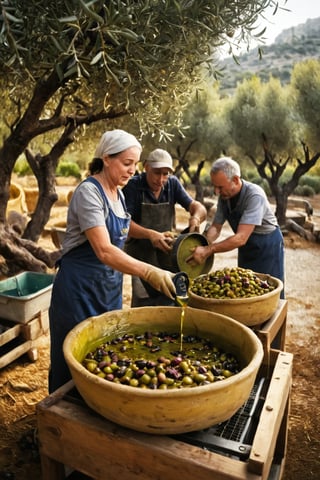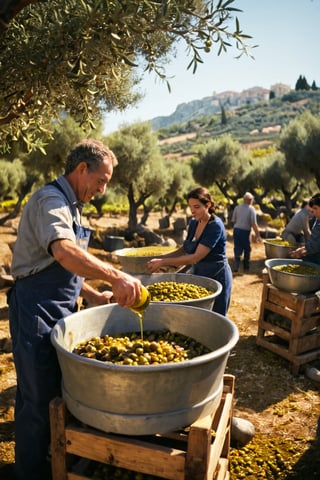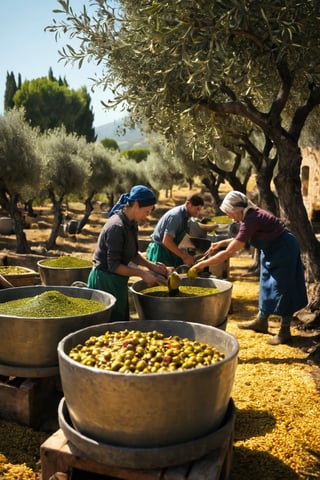LaRecalcada
Published:
Certainly! Here’s a detailed prompt for creating an image that illustrates the traditional process of making olive oil: --- "Create a detailed and picturesque illustration that captures the traditional process of making olive oil. The scene should progress from left to right, set against the backdrop of a sun-drenched Mediterranean landscape with olive groves and a rustic olive mill: 1. **Harvesting:** Begin with a serene scene in a lush olive grove. Show workers hand-picking ripe olives from ancient, gnarled olive trees. Some workers are using small ladders or hand-held rakes, while others are collecting olives that have fallen onto large nets spread beneath the trees. The background should feature rolling hills and perhaps a glimpse of the sea. 2. **Transporting and Cleaning:** Illustrate the olives being transported in baskets or wooden crates to a nearby olive mill. Show a worker pouring olives into a cleaning machine where they are washed and sorted to remove leaves, stems, and debris. Capture the fresh, green appearance of the clean olives. 3. **Crushing:** Depict the olives being crushed in a traditional stone mill. Show large, circular millstones rotating to crush the olives into a paste. Highlight the texture of the crushed olives and the rich, deep green color of the emerging paste. 4. **Pressing:** Visualize the olive paste being spread onto mats or pressing discs, stacked, and then pressed to extract the liquid. Show an old-fashioned hydraulic or wooden press applying pressure to squeeze out the olive oil and water mixture. The liquid should flow into a container, with the golden oil beginning to separate from the water. 5. **Separating:** Illustrate the separation process, where the mixture is allowed to settle, or it is centrifuged to separate the oil from the water. Show a clear container where the pure olive oil rises to the top, leaving the water and sediment below. 6. **Filtering and Bottling:** Transition to a scene where the freshly extracted olive oil is being filtered to remove any remaining impurities. Portray the oil being poured into glass bottles, ready for storage. Include workers carefully labeling and sealing the bottles, emphasizing the clarity and golden hue of the oil. 7. **Tasting and Enjoying:** Conclude with a vibrant Mediterranean table setting where the final product is being tasted and enjoyed. Show small bowls of olive oil for tasting, surrounded by fresh bread, herbs, and ripe tomatoes. Capture the warmth of the sun and the inviting ambiance of a traditional olive farm. Use warm, golden lighting to evoke the Mediterranean sun and detailed textures to highlight the olives, the stone mill, and the clarity of the oil. Each stage should be clearly labeled to guide the viewer through the artisanal process of olive oil production." --- This prompt should vividly portray the traditional and artisanal process of making olive oil, capturing the essence and beauty of the Mediterranean landscape and culture.
Comments






